#Our special iconography
Explore tagged Tumblr posts
Text
What am I thinking about?

The significance of photographs as symbolic conduits of love. Photos supposedly convey 1000 words and in Spiderverse they say what words won't.
Photography is a traditional part of Spiderman iconography. Peter Parker is conventionally recognized as a photographer at The Daily Bugle. We get this even in the form of LEGO Peter Parker in ATSV. Capturing photos in order to document for the news and make a living because well, Spiderman can't make money from saving the city. Sure, we have variations like Holland's who does some videography but The Daily Bugle photographer is pretty typical.
In Into the Spiderverse we have Peter B. Parker looking at a photo of MJ in Peter (1610's) hideout. There's so much yearning and longing because he and his MJ are yet to make up concerning their marriage but he clearly can't stop thinking about her and eventually resolves to make it work.
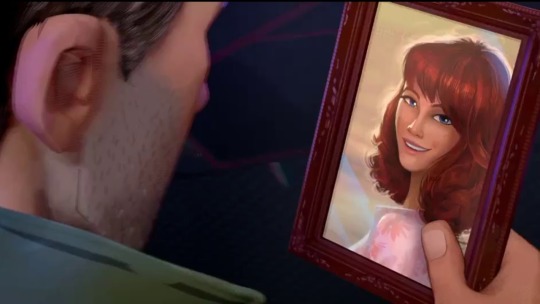
Later in the film we have Gwen cherishing the memento on her cellphone of her and Miles from the bus to Hudson. This photo becomes a pivotal motif throughout the next film. It helps her to feel more convicted and less alone as Spiderwoman. Propels her when she can't get back to Miles. It is so important to her that she prints it out so that she has a physical photo. It's kept in her drumset which holds her dearest belongings and it's the only thing she comes to reacquire after her expulsion from the Spider society. She prioritizes claiming this photo over seeing her own father. (We know why).


We've got Miles equally pining about the gulf separating him and Gwen documenting her image through his drawings. This is a cathartic pastime, and it also helps him to remember her face since he doesn't have any images with him like she does. His replication then of her image is how he channels his affection, admiration and loneliness. He draws all the friends he misses but having drawn Gwen many more times its quite clear how he feels about her.
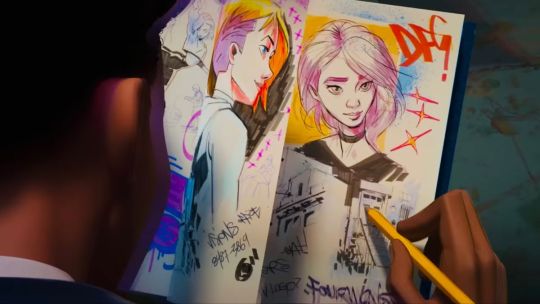
We've got Gwen's Peter using his camera to document not only Gwen but her alterego Ghost Spider, foreshadowing our discovery that Peter has known for a long time that Gwen and Spiderwoman are one and the same and he wants to be special like her. And he loves her, all of her. Or so he thinks.

Lastly, we have Miguel who revisits images and videos of his daughter because he has lost her to eternity. The pain, guilt and grief he shoulders are immense but he claims that he doesn't always like what he has to do and I believe he is carrying out a lot of his actions concerning the multiverse in the name of his daughter.

Photos or drawings - all require attention to detail to capture essence adequately and after the act provide a concrete mode of connection when there's physical distance.
Longing, yearning, loneliness. The need for focus on a cause. Reminiscence. Unconditional, unfiltered love. The reasons for these sacred images overlap and give the films even more emotional resonance.
There are more instances of course. Images are also used in the film for surveillance for example, as shown in my first image. But I wanted to focus on this use in this post. Looking forward to the significance of Gwen's Polaroid in particular in BTSV.
#ghostflower#gwiles#miles morales#gwen stacy#across the spiderverse#into the spider verse#peter parker#spiderman#photography#miguel o'hara
142 notes
·
View notes
Text
taking relentless severe psychic damage from watching several hours of videos of television commercial advertisements from the United States in December 1999.
a world-historical moment, an all-time high peak of self-assured smirking arrogance.
ascendant home computers and internet modems. a new millennium! a time after Cold War but before Nining Leven, with saxophone-playing heads of state and cheery Spielbierg-ian sentimentality attempting to plaster over 1970s/1980s disappointments and hangovers with renewed millennarian End-Of-History optimism.
come celebrate with us! look at these images of The Nation! from sparkling Times Square and the cast of "Friends" in bustling cosmopolitan New York City, to sunny Californian prosperity, to those cartoonish frogs in the quasi-mythical Deep South-ish rural periphery of Budweiser ads, and all the suburban Midwestern Kay's Jeweler's in between! planetary hegemony. "Head east from the Colosseum, across the ruts of chariots, and you'll find an imperial estate built by a second-century Caesar. It's a rough ride. And if the agile and durable Chevy Tracker can handle these ancient roads, driving back home will be a walk in the park. Chevy Tracker: It Gets Around!"
or perhaps "our" power extends beyond this terrestrial imperium, into space, conquering the stars. UFOs; space aliens; The X-Files; Independence Day; Space Jam; Men in Black; the Phoenix Lights; Coast to Coast AM on the radio; Space Command in Colorado Springs.
the anxious fragility belied by the desperate constant promotion of an almost religious dedication to recognizable icons.
talking chihuahuas, marketing jingles, annual football game events. self-referential circular cross-promotion maelstrom.
"An all-new holiday spectacular, a Christmas special destined to become a family classic! With music from REM's Michael Stipe, voiced by Ally McBeal's Peter MacNicol, and starring Drew Barrymore! It's Olive the Other Reindeer! At 8/7 Central Fox Friday!"
trying to insist that this "classic" cultural iconography binds us. it has always lived in your heart. fabricating in real-time a supposedly shared history, insisting on this "reality" even at the moment of its very creation. hammering away at the soul.
Daffy Duck saunters in and pronounces: "Eat your way into the new millennium with this 'gigundo' party sub from Subway!"
why aren't you smiling?
132 notes
·
View notes
Text
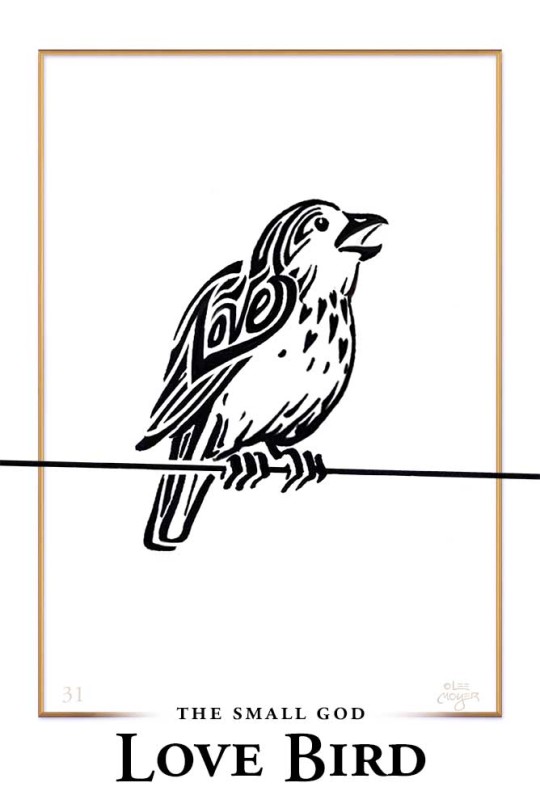
[image description: A white background with very thin gold frame. A black wire crosses that frame at a slight angle. Centered in the frame is a singing bird rendered in ink lines. It has small heart markings on its chest and the word ‘Love’ on its wing. Text reads, “31, The Small God Love Bird”]
Love never dies. It changes forms, yes. It fades and falls into memory. But as time is eternal, love is eternal, forever preserved somewhere in the clinging amber of the past, unable to fully pass away.
Gods of love are similar. They flock around all its many forms and manifestations, from the small god of puppy love to the small goddess of first kisses, and some of them are venerated and some of them are forgotten, but all of them were, at least for a time, and so all of them will be forever.
The most important are always the first to fall. Everyone remembers Aphrodite, in her famous see-through nightie, goddess of love and beauty and marrying for your own heart’s happiness, but how many remember the demigods who served under her? They carried her intent into the world, and as a reward, their names were lost to history, lover’s letters left unread and untranslated, lover’s prayers unanswered. For them, forever is a long and silent place.
But those with less import have a way of holding on.
We say messages fly on the wings of love. We compare our hearts to birds held captive in cages made of bone. We call love itself the thing with feathers. And so, although it has no name, no clear plumage or identity, the love bird endures.It is a small god of all that loves, all forms of love, non-specialized yet still diminutive. It spreads its wings to cover lusty lovers in the grass and sleeping siblings in their sleepaway tent at the same time. Love is love is love, whether sexual or familial or the deep, complicated bonds of friendship, and the love bird perches on them all, feathered and fleet, too small to die, too enduring to ignore.
Its iconography is everywhere. It will never fly away and leave us, but will love us all and always, and sing its songs just on the edge of hearing, where all ears are open as they tumble into sleep.
Love is love.
____________________________________________________________
Artist Lee Moyer (Trident of Aurelia, 13th Age) and author Seanan McGuire (Wayward Children, October Daye & InCryptid series) sincerely thank to each and every one of you who share Small Gods!
Tumblr: https://smallgodseries.tumblr.com/
Instagram: https://www.instagram.com/smallgodseries/
Homepage: http://www.smallgodseries.com/
Monday, Wednesday, and Friday.
190 notes
·
View notes
Text
After the Summer Olympics’ opening ceremony, drag artist Nicky Doll felt she was on a cloud. Her makeup had survived 45 minutes of torrential rain as she performed on a bridge over the Seine River and she’d just witnessed waacking and voguing, both dance forms with queer roots, reach a worldwide audience of billions of people.
Back in the dressing room, which was on a boat, the mood was celebratory. “We were all so proud that in 2024, we were given the platform to be,” says Doll, known for her appearance on the reality show RuPaul’s Drag Race and as the host of Drag Race France.
It wasn’t until the next day that Doll realized she was also at the center of an Olympic-sized backlash. French Catholic bishops decried the ceremony’s “derision and mockery of Christianity.” Donald Trump called the show “a disgrace.” Critics focused their anger on one scene, where Doll posed alongside other Drag Race artists, interpreting it as a parody of the Last Supper, a painting by Leonardo da Vinci and an important image in Christian iconography. Organizers denied that was the inspiration. But by then, it didn’t matter. The online mob had its momentum.
On Doll’s phone, that momentum took the form of a slew of notifications. Her name was getting tagged. Personal attacks were filing into her DMs. Then came the threats: “we know where you live,” “we have guns,” “we will cut your throat.” Other performers were getting harassed, too. A special police unit dedicated to fighting hate crimes was tasked with investigating online abuse targeted at lesbian activist DJ Barbara Butch, the Paris prosecutor's office told the Associated Press.
“As queer people, we are used to being criticized on social media,” says Doll, who is from Marseille but now lives in New York. “But when we saw they were using religion … in order to attack us, this felt like a low blow that we didn't see coming.”
Behind the messages were the usual crowd of anonymous trolls, hiding behind accounts with no names or profile pictures. But among them was also Laurence Fox, a British actor turned right-wing commentator, who has become notorious for making misogynistic and homophobic comments. On the night of the opening ceremony, amid the backlash, Fox posted a video of the catwalk scene on X, calling the cast “little pedos.” The post remains visible on the platform with a fact-check label that says: “There is no evidence that any of the people in the photograph are pedophiles.”
In response, Doll, who features in the video next to Butch, decided to sue Fox for defamation in France. “I want to sue him personally, because I want him to understand that he cannot continue to use us for his personal agenda and his words matter,” she says, “The message that he sends to his fan base matters. He's an enabler for hate and homophobia and transphobia.” Representatives for Fox and X did not reply to WIRED's requests for comment.
For Doll, the concern is that the type of rhetoric that came in response to the opening ceremony, if left to spread unchecked, could inspire offline violence. “Queer people could be literally murdered in the streets,” she says. “It’s very important that we stop allowing this kind of rhetoric to demonize queer people. We are not demons. We are not trying to attack religion and families. We are just trying to live our lives and to have representation in the media for other people who are not loved or have not even come out to feel like they are seen.”
This is not the first time Fox has been sued by someone in the drag community. In April, a British court ordered him to pay £180,000 ($200,000) to Simon Blake, incoming CEO of British LGBTQ+ campaign group Stonewall, and Crystal, another star in the Drag Race universe, after calling the pair pedophiles on X.
Doll is hoping her case can dispel the idea that online mobs have to be endured alone. “I am showing them that the law is an option they can [pursue],” she says. “The government is on their side and there are things they can do when they are being attacked.”
Doll, who received the majority of the attacks via Instagram and X, says the two platforms have not been equal in their attempts to contain the abuse. “I think that Instagram and [parent company] Meta are doing as much as they can,” she says. After reporting DMs she received through the app, the company responded to tell her those profiles had been removed.
On X, however, she feels like there are barely repercussions for people spreading abuse. “I think that Twitter is a trash can of negativity and allows so much hate,” she says, using the platform’s previous name.
Yet this is not just about abuse targeting celebrities. “What worries me is that people are going through things like this,” she says, “who do not have the power that I have.”
17 notes
·
View notes
Text

Bang Creator Interview: Tumblr: @littlebreadrollart | AO3: InkedConstellations | Twitter: littlebreadroll | Bluesky: littlebreadroll
The Collaboration period has begun! In these quiet months before works are due, we want to foster a sense of excitement, camaraderie, and celebration among our participants. To that end, all participants were given the option of a formal interview by our mod, Dema, or an informal “ask-game” survey. We hope you enjoy getting to know our phenomenal creators as much as we have!

Interview with Dev
Dev and Dema talk horror media, the Deep Roads, and too many eyes (or: can there every be too many eyes?)
Dema: Is this your first time participating in a Big Bang as an artist?
Dev: It is! I've participated in some zine events in the past, but only as a writer. I'm very excited to be an artist this time around.
Dema: What inspired you to join?
Dev: I've been a fan of Dragon Age for a long time, but wasn't really sure how to join in the fan community. Things have been a lot more active recently since Veilguard is coming soon (finally), so I thought 'It's now or never! Might as well go big or go home.'
Dema: When you do a collaboration like this, what is your process like? How do you start?
Dev: I usually start by reading the prompt and seeing what comes to mind, and then talking with my partner about their vision for the piece. As an artist in particular, I feel like my best inspiration comes from the passion other people have for their projects, so it's important to me that what I settle on is both something I want to draw and something the writer really wants to see! From there, I sketch a few thumbnails on paper before I really sit down to work digitally. I like to take my own reference photos, so my roommate puts up with a lot of unusual posing requests.
Dema: Oh I love that, having your own references is so valuable. Besides the source itself, is there anything else inspiring you a lot right now?
Dev: I'm a big fan of horror media in general, so I'm always being inspired by that. Anything that leaves the impression of being slightly wrong or off is always a great piece in my opinion--the kind of thing that lingers in your brainspace. I'm reading a lot of korean webnovels lately too, so I've been invested in their flair for the dramatic. But ultimately, I'm inspired by the idea of trying something new.
Dema: Dragon Age has a lot of horror elements, but is there a particular game in the franchise, or theme, or even a moment in DA that scratches that itch the most for you?
Dev: I started with Dragon Age: Origins, and it'll always have a special place in my heart. I think the moment I fell in love with it was actually Branka's Deep Roads quest--walking through the pulp-filled hallways while that poem is being recited still sends shivers down my spine! I know it's a bit controversial among fans because they're such a slog at times, but the Deep Roads are my favorite part of any DA game.
Dema: What do you think will be the greatest challenge for this piece you're working on for the bang? Without giving away too much 😉
Dev: Definitely the expressions. I picked a really visceral moment in the fic, both physically and emotionally, so I hope that the finished result gets the right feelings across. They say eyes are the windows to the soul, after all!
Dema: Do you consider yourself primarily a portrait artist?
Dev: I would say more character artist than portrait, since I feel like the entire body pose works to communicate a figure's personality and emotions. But eyes are definitely my favorite part of drawing. So much so that I often find excuses to add extras 😂
Dema: Hahaha does this mean you love the Dread Wolf iconography?
Dev: I do! I admit, I wasn't much of a Solas fan when I first played Inquisition. But the Dread Wolf designs have really grown on me.
Dema: When did you first play it? Did you play them as they came out?
Dev: I wish! I didn't even play DA:O until 2017, my sophmore year of college. My boyfriend at the time introduced me to it, but before then I wasn't much of a video game player at all. You could say that Dragon Age really changed my view on how fun it could be to play video games. I spent a few years being obsessed with Origins and Awakenings, but after that I played DA2 and Inquisition right in a row.
Dema: What is the most fun aspect of the games, in your opinion?
Dev: The lore, hands down. I'm the type of player that reads every scrap of paper and book I get my hands on. But more than just learning about Thedas, I like to use that information to change how my character interacts with the world. It's also really fun to read other people's theories.
Dema: Do you have a favorite OC you've created?
Dev: I think our first is always special to us. I began with my Warden, Sigilla, as a casteless dwarf. I went in blind with her, so I really felt like we were both discovering the world at the same time. But my Inquisitor is a close second!
Dema: When did you first make art for Dragon Age? Why did you start?
Dev: I started out with little napkin doodles back when I was first playing Origins. They were just to pass time so I didn't end up keeping most of them, but I started because I was absolutely obsessed with Alistair. I just drew his goofy little face everywhere!
Dema: Is he your favorite companion/romance?
Dev: Yes, he is. Every time I replay DA:O I tell myself I'm going to make different choices, but I just can't bear to break his himbo heart. Tell me that when he pulls out that rose you could look him in the eye and turn him down!
Dema: Last question: are you art-ing today? If so, is there anything you'll use to help you get into the zone?
Dev: I am! When I draw, I like to make sure my space is really clean so I don't have any distractions. Usually I just keep my sketches out, and I'll listen to a podcast or random youtube videos and let the white noise keep my thinking brain occupied so I can really go at it. Right now I'm on my 4th listen of the Magnus Archives--it may be spooky, but there's just something about a vaguely British man reciting horrors in a deadpan tone that's really relaxing.
Dema: Oh, I think those are great vibes. I hope you have a wonderful drawing session! Thank you for taking the time out of your day to be interviewed.
Dev: Of course! It was great to talk to you. I'm really excited to be a part of this project, and I hope that everyone who reads the fic I'm paired with enjoys it! It's inspired me a lot.
6 notes
·
View notes
Text

Hiya there, shippers & readers
After our usual game/watch-along round was profoundly derailed by some recent fandom events, we really feel like our response and the time we spent spilling our hearts in our fandom-vent channel made us that much closer. We got some new members and we've had a lot of new fun times. It feels like we're ready to embark on a new chapter of reading fic and discussing it together. It also brought about another sentiment; a special desire to interact with something in our beloved fanspace that doesn't always get a lot of love. That is, the steven fic.
And there is a lot of it, surprisingly. Ranging from the early years in the background of shyan or featuring in his own peculiar way in pairings and threesomes, either way, we decided that it was really time for us to show some love for fiction!Steven in hopes to inspire more. Due to that, we voted in 9 nominations and decided that the top 3 would stand as milestones in our Steven season journey. Among those three, the top of the vote was a very particular favourite of this mod's
under thy tongue by makemadej (santamonicayachtclub)
The book club as a whole seemed to agree that this fic is holistically a beautiful piece, that it reads like what it must feel like to observe the iconography of classic artists painting god and the angels in all their mythos as Steven navigates an ephemeral opportunity to be intimate with Ryan.
Rating: E
Summary: Ryan sprains his ankle because basketball and ends up staying at Steven's place. Guess how many beds there are.
Book Club Thoughts
First off, I'm a shyan shipper but…. this fic really sold me on this pairing we don't get enough opportunities to talk about steven/ryan as a pair esp since ryan is such an open book but he's the kind of guy who feels a lot of guilt about purchasing big things for himself and mean while Steven is more reserved but there has always been something so wonderfully hedonistic about him the setting of it feels very liminal, and it adds to the tone The nature behind Steven almost feeling like this is something he may not be allowed to have as the thought of Shane lingers over his head even though the dude is on the other side of the world, yet Steven is still there to take care of Ryan in all the terms. It's just how beautiful Steven's character and personality is written in this fic. i love stevens religion being used as a tool of indulgence rather than restriction. he is fully worshipping ryan. a man so beautiful you gotta experience him in a biblical sort of way And all of this being from Steven's pov just really fits his love of the nicer things and his appetite so well his saying "there's nothing wrong with wanting" feels so poignant to how he operates here to the end of the fic. He has always had desires but he doesn't steal and he didn't want to feel like he was stealing Ryan so when Ryan starts to ask him to do things that he--Steven-wants to do, it's surprising to him. it's about the devotion to god and Ryan's godlike physique that can't be anything other but the manifestation of god's love on earth i adore the dream-like quality of this fic. the liminal energy of the timeline and that they know they wont be staying together, yet it's still so intimate and loving There is such beauty in the way he is written; a kind, quiet, methodical individual. His language of love being acts of service is so fantastically written. It’s true service… and yet there’s the quiet self satisfaction Steven indulges in as he’s…. servicing Ryan….. This fic is a quiet, calming, dare I say meditative read. It’s comfort, somewhat bittersweet in the way their entanglement is temporary.
WOULD YOU LIKE TO JOIN US FOR OUR NEXT DISCUSSION? CHECK OUT THE FAQ, AND SEND US AN ASK! IF YOU’RE LOOKING FOR FIC RECS, PLEASE CHECK OUT OUR READS, NOMINEES AND BOOK CLUB REC LISTS!
#shyan#stryan#limgara#limgara fic#pre-watcher era#bed sharing#hurt comfort#biblical themes#somewhat unrequited#read of the week#sbbookclub#steven season
17 notes
·
View notes
Text
So, I found this post [https://www.tumblr.com/mashounen1945/772060782838087680/stuffedeggplants] by @mariacallous and @sprinkledsalt with other valuable contributions by @anartificialsatellite, @smegorl, @stuffedeggplants, and @stripedroseandsketchpads. In light of the recent release of Robert Eggers' remake of the 1922 classic Nosferatu: a Symphony of Horror, all these users addressed various aspects related to the problematic (for lack of a better term) legacy of the vampire sub-genre of horror in general —and movie adaptations of Bram Stoker's Dracula in particular— and their little-known but inescapable ties to antisemitism due to the disturbing similarity between a vampire's most usual traits and several antisemitic tropes.
This is some extremely interesting material, highly relevant to the current times, and I cannot recommend enough to read it in its entirety, that is, including everything added by others in the reblogs. When I reblogged it myself, for a moment I considered adding a comment, but ultimately decided against it: the things I was planning to talk about were barely related to that post's main topic; more importantly, it felt like I'd be joking about a very serious subject and mocking what everyone else contributed with, and I'm sure you'll understand why when I go into details later. In the end, I chose to talk about those things anyway, but on a post wholly separate from the original.
-------------------------
During the last few months, I came across a meme that has been going around a lot these days (or at least it was popular a few years ago and I'm just catching up now): a scene from Curados de Espanto (it could be literally translated as "Healed from Fright", but the context would turn it into "Helluva Healed"), a Mexican comedy movie parodying vampire stories. For reasons beyond human comprehension (or because the movie didn't become famous in any way, shape or form), the scene in question didn't leave a black mark on Mexico's reputation: a Van Helsing wannabee called "The Great Jacinto" faces a vampire and pulls out a crucifix to get rid of him, but this doesn't work and the vampire reveals he's Jewish, which is implied to render him immune to the effects Christian items and iconography would normally have on a vampire; but worry not, Dear Reader, for that The Great Jacinto is prepared for any and all contingencies (I guess) and he proves this... by pulling out a clearly shoddily-made swastika as he screams a deeply unfortunate German phrase made of two H-words, which doesn't even work either and simply scares the vampire and makes him look to the side for a few seconds (our hero, everybody: he speedran the satire-to-Fascism pipeline, and it was all for nought).
Also during the last few months, I started playing Touhou games, skipping the PC-98 era and going straight to the first title released for Windows: Touhou 6: Koumakyou ~ The Embodiment of Scarlet Devil. The main antagonist and final boss (unless you count the game's Extra Stage) is Remilia Scarlet, a little girl sporting the full package of vampire tropes and then some: she's been living for 500 years while staying young (but this makes her a very experienced adult trapped in the body of a little girl, and the Internet totally didn't get horny on main for that, no sir), can turn into a bat that's also immune to the player's special attacks, has a bunch of good-looking but also highly formidable and loyal female servants defending her mansion (who are also awesome for their own reasons), claims to be the direct descendant of Vlad Țepeș Drăculea himself (which is actually a complete lie according to TouhouWiki, but I still have to check that), etcetera. Unfortunately, that "full package" of vampire stuff also includes Remilia embodying an antisemitic trope, as her attacks are designed with an aesthetic insinuating that either she's Jewish or her being a vampire has something to do with Judaism: she's constantly summoning glyphs that are just the Star of David on a circle (and those glyphs also shoot their own bullet curtains at the player), while a bigger version of such glyphs surrounds Remilia herself during the entire battle; Flandre Scarlet (her secret younger sister, and the true final boss in the Extra Stage I mentioned earlier) does the same things, and Patchouli Knowledge (one of the earlier bosses, and the mini-boss in the Extra Stage) attacks by bringing books with a Star of David drawn on their pages and shooting from them as if they were magic turrets or something.
Both examples aged like milk, that's for sure. But on the other hand, they kind of ended up being very inconsequential.
In particular, the Touhou case could be chalked up to Japanese authors not going outside or touching some grass as much as they should, adding things to their stories that simply looked cool without sitting down and thinking about their implications for five seconds. Touhou 6 is far from being either the first or the last time this happens in popular Japanese media: the creators of Neon Genesis Evangelion openly admitted that Rule of Cool is the sole reason behind all the Christian imagery in that anime; even ZUN (the creator of the Touhou series, and the one-person team of developers for the series' mainline games) did something similar immediately after Touhou 6 since the Extra & Phantasm Stages in Touhou 7 and 8 have Ran Yakumo, Yukari Yakumo and Fujiwara no Mokou flashing their own swastikas in front of the player during their respective boss battles.
As for Curados de Espanto, I'm fairly sure people only started caring about it quite recently, when they had better access to the Internet and that scene became the meme it is now. Really, what still gets me about this whole thing is something entirely different and much more important that also happened some months ago: an amazingly high percentage of Mexicans, most likely including lots of people who laughed and still even laugh at that meme, voted for a left-wing scientific Jewish woman to be their President for the next six years while the rest of the world fell back into Fascism's hands.
#Dracula#Count Dracula#Bram Stoker#Nosferatu#Robert Eggers#Nosferatu 2024#Vampires#Gothic Horror#Vampire movies#Curados de Espanto#Jacinto el Grande#Touhou#Touhou Koumakyou#Koumakyou#Kōmakyō#Touhou Project#Touhou 6#Mexican movies#Horror parody#Horror comedy#Touhou EoSD#Embodiment of Scarlet Devil#The Embodiment of Scarlet Devil#EoSD
3 notes
·
View notes
Text
l'aventure de canmom à annecy épisode DEUX - lundi 2 - cats and pigs
So this one's going to be a little chaotic in terms of order of events but hey. Let's gooo.
First up! I saw Flow, as mentioned earlier. Director Gints Zilbalodis from Latvia was the very first person to win the Contrechamp award at Annecy in 2019 for his solo-animated movie Away. Now he has a team, and they decided to make a totally wordless movie about a cat. Honestly I could leave it at that - this is a movie which you should watch unspoiled and just let it take you on a ride - but for a more detailed summary...
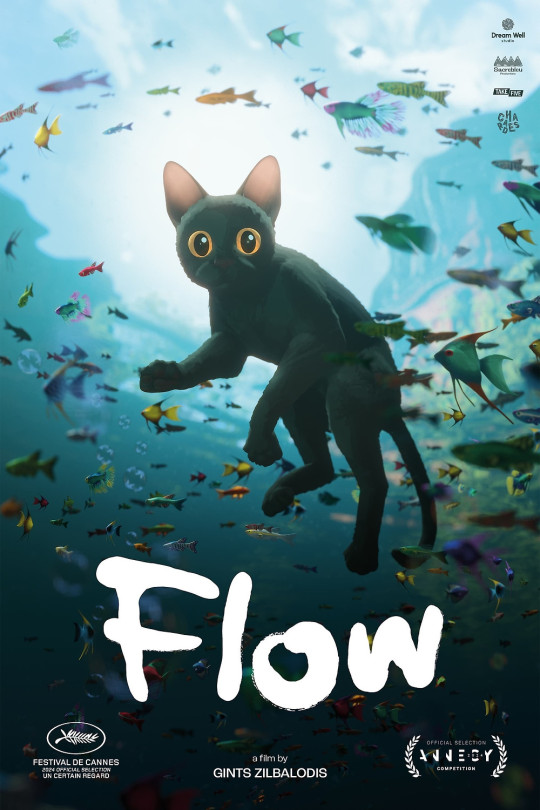
Our adorable little cat is living alone in the forest, surrounded by statues left by their former owner, when the world abruptly gets flooded, sending the cat on a journey to try to find higher ground and survive. The cat falls in with a group of other animals - over the course of the film, this group grows to include a capybara, a ring-tailed lemur, a secretarybird and a dog. It's the story of the struggles of these animals as they try to navigate the rising water towards higher ground, dealing with both outside threats and conflict within the group. I won't tell you where they end up but things get a tad mystical.
The thing is this film is totally wordless. The animation has to do absolutely everything. And it does so with aplomb. This is hands down some of the best character animation I've ever seen in a CG movie. Every animal moves naturally and expressively, their relationships shown with humour and clear expression. I honestly don't know how they did it so well.
It's also gorgeous on a rendering level. I'm not entirely sold on the posterisation effect used on the animals, but their environments are so vivid and richly detailed, looking natural even as they enter stranger architectural zones. Under water, over water, in storms... it looks absolutely great. It makes me so happy that this was done in Blender, it's like, that's what we dreamed of back in the day on the blenderartists forums.
The film already got a Cannes nom, which is wild for animation, and honestly while I haven't seen the other features yet, this is gonna be a tough act to follow and I think it has a pretty good shot at winning. I have no insight into the mind of the annecy jurors though! Regardless, spectacular film, makes me really want to make shit in blender lol.
I got some photos of the team getting a standing ovation at the end but it's super late so I'll have to upload them later lol.
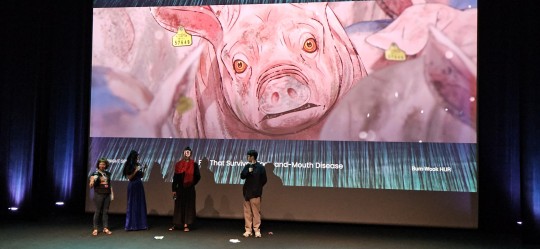
Later I saw the premiere of The Pig That Survived Foot and Mouth Disease, a new Korean film which makes a much better case for using mocap in an animated horror movie, also in the midnight specials slot. Impressively all the roles of around 30 characters were played by one mocap actor, which is wild. It's a classic Korean style of film - a spiral of death and trauma rooted in social violence, particularly military hazing and animal agriculture.
A pig, surviving the mass slaughter of pigs during the foot and mouth epidemic, eats the body of the farmer who raised him and transforms to become more human and becomes something of a cult leader for wild boars; a military deserter becomes a yeti-like creature but finds new hope when he rescues a girl from her suicide attempt, but is she even real?
It calls to mind films like King of Pigs and The Fake, and it's no less uncompromisingly bleak in its view of society - but by comparison to those films, it's shot very stylishly, with a cool nonphotorealistic shader and a frequently gorgeous forest setting. It's not as fancy as something like Flow, the models looking a little videogamey at times, but it's definitely solid - the rigs detailed enough to capture the acting. The style works very well for the film, and there's a couple of really standout stylised sequences, playing with religious iconography or dream sequences.
The film it reminded me most of is actually Unicorn Wars, another violent story of transformation and people going a bit nuts in the woods. But it also gets a bit Shakespearean with all the stabbings by the end.
Whatever you compare it to, it's a compelling drama, unblinkingly facing the cruelty of society. The two directions of escape - the human who wants to live like the animals, free from social cruelty, and the animal who wants to live as a human, free from the imminent threat of death, present a strong contrast and a good pincer movement on the theme of what it means to be human.
Sadly it didn't have nearly the turnout as WSDIB, but I did get to tell the director and mocap actor I liked the film - unfortunately I don't know enough Korean to really ask the questions I wanted to (though I learned they used Unreal for rendering) but the director did very kindly run over to his friend to give me a little postcard with some art.
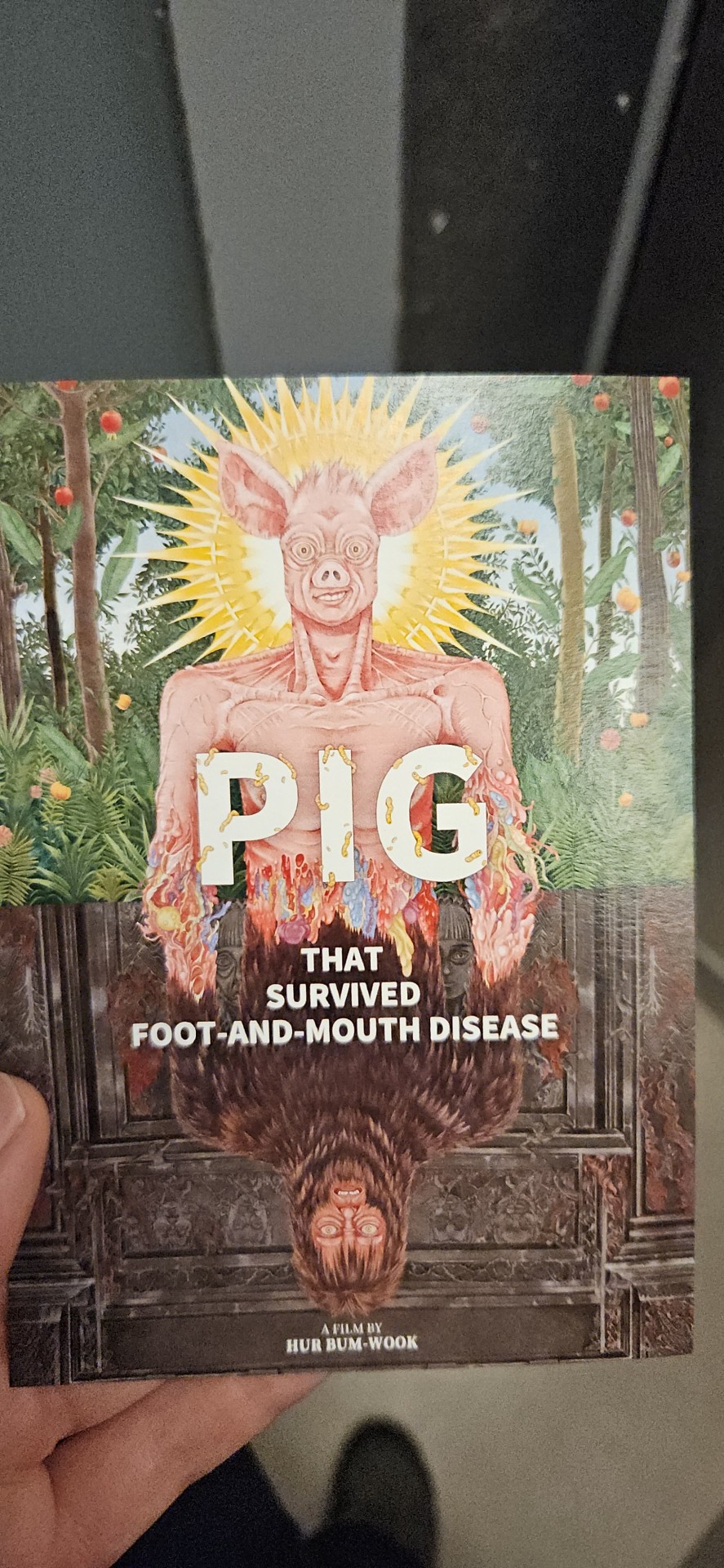
I wish the crowd had been more enthusiastic tbh, this was a good movie!
I also watched a bunch of XR stuff today, and another WIP panel for Canadian film Death Does Not Exist which is looking real cool, more on that in a mo... and I met Malaysian director Suresh Eriyat in a comic book shop and bought his art book direct from him which he fully signed for me, bless him...
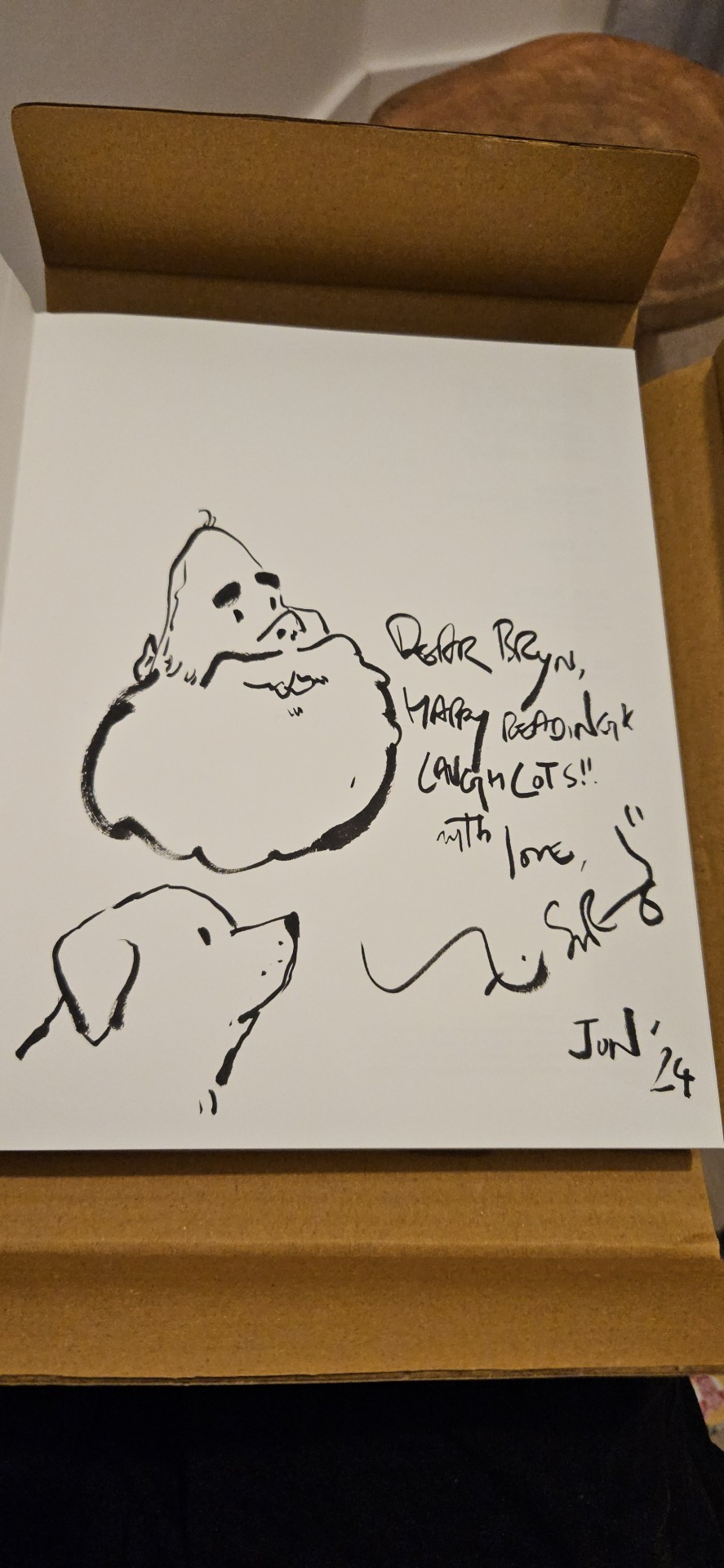
seriously how adorable is this?
12 notes
·
View notes
Text
In July 2015, the North Carolina legislature passed a law requiring legislative approval to change or remove monuments erected to honor “an event, person, or military service that is part of North Carolina’s history.” Floor debate before the legislative vote clearly established that the bill was written as a response to efforts to remove Confederate flags and memorials in other states after a white supremacist shot and killed nine Black men and women in a historically Black church in Charleston, South Carolina, on June 17, 2015. The removal of the Confederate flag from the South Carolina capitol grounds weeks after the shooting was welcomed by many but also sparked criticism and backlash from those who insisted it was a representation of heritage and history rather than racism and pro-slavery ideology. “The whole purpose of the bill, as I see it, is to keep the flames of passion from overriding common sense,” said North Carolina Representative Michael Speciale. On July 20, 2015, the State House passed the bill. Days later, on July 23, Governor Pat McCrory signed it into law, citing his “commitment to ensuring that our past, present and future state monuments tell the complete story of North Carolina.” According to a study by the University of North Carolina at Chapel Hill, the state has more monuments to the Confederacy than to any other subject, and more than half of the state’s counties have at least one Confederate memorial.
For more on the scope and depth of the South’s commitment to Confederate iconography, see EJI's report, Segregation in America.
#history#white history#us history#jumblr#black history#am yisrael chai#democrats#republicans#North Carolina#University of North Carolina#chapel hill
4 notes
·
View notes
Note
Hello, Mr. Quackity. I've two updates for you from the bar, sir: the first, is to mention initially a wrong that was done. A line cook from some restaurant or another was hanging around the back of house with one of our own servers and on the server's break, lit a dumpster on fire. There was no damage to the building, or the dumpster, for that matter. However, interestingly, the fire melted a mirror in the alley and made quite an peculiar piece of art. We've hung it on the wall and are considering glass and fire themed drinks for the first new menu of the year.
In other news, though some of our regulars are enthralled by the new decoration, the others have organized a 'gang' of sorts. I've no understanding as to why they've done it. But their goal is to force us to add something of the president himself, to the grounds. Say that you've been letting your face run less of Las Nevadas every day. Some are requesting new paint around the bottom of the pole platform, wings like you've been seen with. Others suggest (I think jokingly) a special drink to commemorate you. There's one individual in particular that is demanding more of your special appearances, though they've been banned from our premises on, ah, multiple of those occasions for their behavior. Disregard them. I only tell you this so you may understand that we have dealt with many a letter, rant, and impassioned bartop speech at this point. We humbly request a statement or action to pacify them. -Laverna
[ the mention of having the image of his wings be used as a visual decoration to the strip club stages is not a comfort. but quackity acquiesces. ]
i'm glad you've remained on top of business, laverna. considering my iconography is already plastered throughout the casino, i'm surprised they'd want extra in the strip— . . then again, i was once a performer myself back before my initial vice presidency. wouldn't hurt.
okay. no statues, for starters. that's something i'd avoid so the nation doesn't start viewing me as a narcissist. if they don't already, that is. ha.
the drink, the paint, that's fine. i recall there was some themed drinks or whatever it was, already in regards to the members of las nevadas— i left myself out, so. a special edition drink could work. it's gotta be a cocktail or something.
#quackitychirps#ask blog#🍹anon#ooc: q hates the concept of his wings as decor. mainly cuz during manburg schlatt often threatened to rip them off and pin them on the wall#behind his desk#etc etc#you get the gist#also woah two links in one post im popping tf off /silly
5 notes
·
View notes
Photo
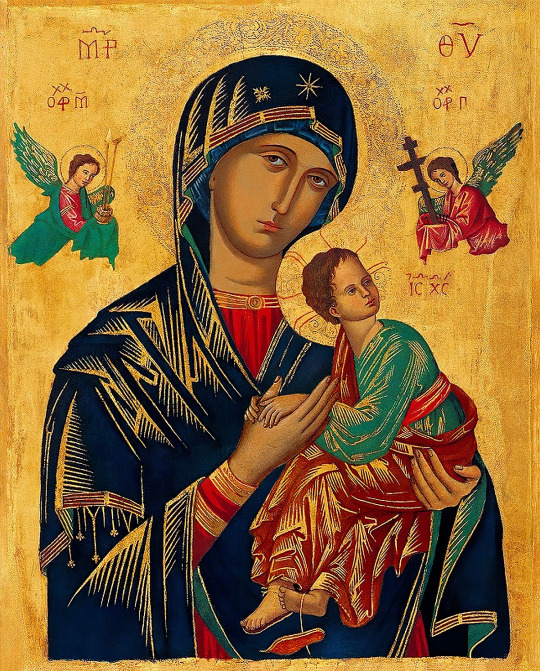
THE DESCRIPTION OF THE OUR LADY OF PERPETUAL HELP Feast Day: June 27
The icon of Our Lady of Perpetual Help represents the Christian mystery of Redemption.
Our Lady of Perpetual Help is a Byzantine icon that is believed to have its origin sometime during the 13th -15th century. The image is also known as 'Our Lady of Perpetual Succour.' The icon is known for being miraculous; over the centuries countless healings and special graces have been attributed to it, so much so that the image has been honored and venerated by many Popes.
The miraculous icon is painted on wood and measures about 20" in height (54 x 41.5 centimeters) and depicts the Virgin Mary, under the title 'Mother of God,' holding the Child Jesus.
The Archangels Michael and Gabriel, hovering in the upper corners, hold the instruments of the Passion. St. Michael (in the left corner) holds the spear, the wine-soaked sponge, and the crown of thorns. St. Gabriel (in the right corner) holds the cross and the nails.
The intent of the artist was to portray the Child Jesus contemplating the vision of His future Passion. Frightened by the vision, he runs to his mother for consolation. The anguish He feels is shown by the loss of one of His sandals as he quickly flees into the arms of his Mother.
Despite a foreboding vision of suffering, the icon also conveys the triumph of Christ over sin and death, symbolized by the golden background as a sign of the glory of the resurrection. The royal crowns on the heads of Jesus and Mary also symbolize their triumph as the King of Kings with his Queen Mother.
In a very beautiful way, the Child Jesus grasps the hand of the Blessed Mother. He seeks comfort from His mother as He sees the instruments of His passion. The position of Mary’s hands – both holding the Child Jesus (who seems like a small adult) and at the same time presenting Him to us – convey the reality of our Lord’s incarnation, that He is true God who became also true man.
Just as the Child Jesus fled into the arms of his Mother when he was frightened, so too do we flee into the arms of our Blessed Mother with child-like confidence whenever fear envelopes our hearts. Just as the Virgin Mother consoled and comforted her Divine Child, so too does she console and comfort us, her spiritual children, in our afflictions. We can always come to her in our time of need and receive her help.
In this iconography, Mary is represented as the one who guides us to the Redeemer. The Virgin Mother is also our Help who intercedes with her Son on our behalf. The star painted on Mary's veil, centered on her forehead, highlights her role in the plan of salvation as both the Mother of God and our Mother.
To this day, the Church of St. Alphonsus in Rome displays the original icon of Our Lady of Perpetual Help. They are the guardians and promoters of the holy icon, the only religious order entrusted with the task of doing so with a venerated image of Our Lady.
Source: The Catholic Company
#random stuff#catholic#feast day#our lady of perpetual help#our lady of perpetual succour#our mother of perpetual succour#nostra mater de perpetuo succursu#nuestra señora del perpetuo socorro#virgen del perpetuo socorro#ina ng laging saklolo#redemptorists
48 notes
·
View notes
Text

He Met the Blessed Virgin, He Painted Her Portrait
Commemorated in the Church calendar on October 24, Saint Luke the Evangelist holds a special place in the Church not just because of his contribution as the author of one of the Four Gospels. Church tradition teaches that he was the first iconographer. Saint Luke painted the holy image of the Virgin Mary on a panel, a face which he himself had seen. He brought his first icons to the Mother of God herself, who approved them and proclaimed: “May the grace of Him Who was born of me, through me, be imparted to these icons.” There are at least five highly-venerated icons of the Virgin painted by Saint Luke which are still venerated today, including Our Lady of Perpetual Help, Our Lady of Vladimir and Our Lady of Czestochowa. He is also known to have painted icons of Saints Peter and Paul. The beginnings of iconography can also be found in the catacomb paintings of the second and third centuries.
See St. Luke's icon here:
5 notes
·
View notes
Text
Today is Pentecost, which is when we commemorate the descent of the Holy Spirit upon Jesus' disciples after his ascent into Heaven. According to the book of Acts, this was accompanied by miraculous events, including prophecies by all classes of people and the ability to speak and understand many different languages.
In iconography, this moment is portrayed with the Holy Spirit (usually depicted in the form of a dove) coming down through holy rays on the assembled crowd. A flame burns above each person's head, symbolizing the indwelling of the Holy Spirit in every individual, and the spiritual gifts and powers that we can access through the Holy Spirit in us.

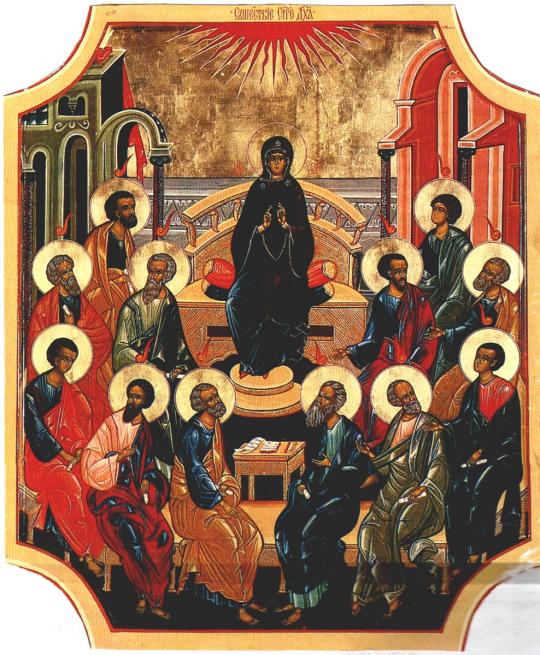

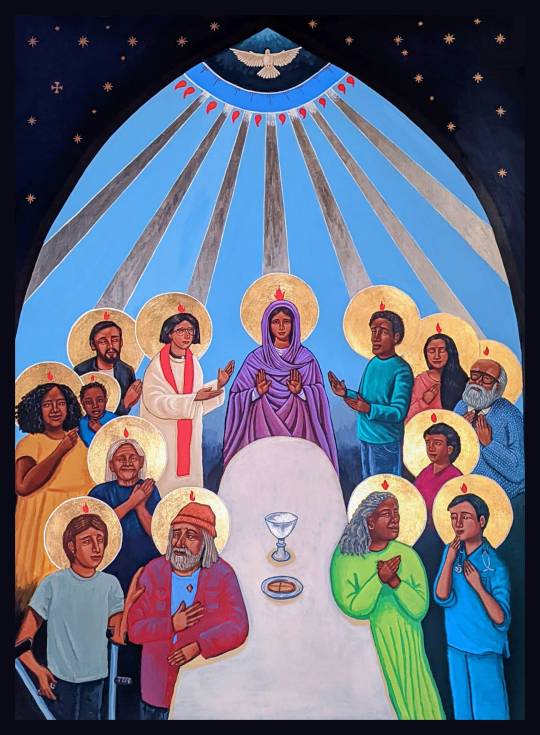
There are also a few features in the liturgy that are unique to the celebration of Pentecost. This was ours:
youtube
The songs, readings, sermon, and a few of the liturgical prayers focus on the significance of the Holy Spirit and what the Pentecost narrative means in the context of when it was written. The vestments and drapery are red, symbolizing fire, passion, blood, and the "burning" of the Holy Spirit within us. (Insert children's hospital joke here.) Red is a powerful color, and is only used during a few special feasts and celebrations throughout the year. This is a lively and joyous celebration, and it's traditional for people to wear red, which you can see on a few members of the congregation. Yellow, orange, and "fire/wind" symbolism are also used. We had banners depicting the Holy Spirit in dove form at the front of the nave. I was the one responsible for ringing the bell during the Eucharist, and I rang it EXTRA VIGOROUSLY, for which I got several compliments. The fire-colored cut roses in vases around the altar were donated to the church and distributed to members of the congregation after the service.
The medieval-looking red cloak that the celebrant is wearing in the opening procession is called a cope, which is worn on special occasions in the Western Church. It comes to us from a style of raincoat or warm outer garment that was worn in antiquity. Today they're normally worn by bishops, and the celebrating priest is the only one of our clergypeople who is tall enough for the one we have at our church.
Not related to Pentecost but interesting anyway: the woman in the gray robe leading the procession and presiding over the liturgy is called the verger, which is an office that is unique to Anglicanism. The verger is the boss and stage manager of the liturgy, and has a few other roles in the management of the church. The staff they carry is a symbol of their authority, and historically was used to push animals or unruly children out of the way. They are always a layperson. Having a layperson in this liturgical role symbolizes the importance of laypeople in Anglicanism, and reminds us that professional clergy derive their authority from the consent of the governed.
36 notes
·
View notes
Text
The Collector's Species (TOH) and The Observer (Serina: The World of Birds) are Interestingly Similar
Despite being from two unrelated fandoms, both fulfill the exact same role.
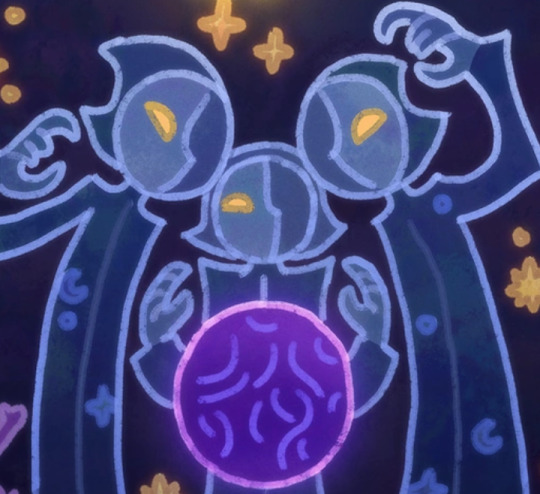
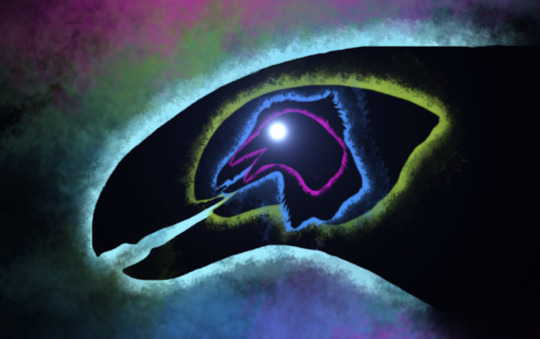
First thing's first; Their designs.
The Collectors' are shown to wear robes with star and moon iconography, and generally seem to have an association with celestial events as shown in the paintings lining the walls of The Archive in "For The Future". They also seem to depict themselves as almost a part of the night sky.
The Observer, on the other hand, has a more ethereal form. They are described as having an eye that glowed bright like a star, whilst manifesting an aurora like physical form that was meant to be familiar to the intelligent life it was speaking to, as to not scare them.

This art (Drawn by Bombnyx) depicting the Observer talking to a character, further shows the celestial symbolism, showing him as if they are literally the stars and cosmic clouds that make up the space around the planet. (Including this because it's probably canon)
These designs visually imply that the space in which they reside (being everywhere around the planets they observe) is under their complete control, making them nigh omnipotent beings that are virtually unstoppable.
Secondly; Their Overall Goals
The Archivists are very mysterious beings, so we can only guess what they do based on what our Collector has told the audience. In "For The Future" the first part of the storybook that King reads to him implies that his species lives to observe life on planets change and evolve over long periods of time. In order to preserve their species in the case that they go extinct (naturally or not) they collect members of their species to be preserved.

The Observer does something very similar, albeit in a much less invasive manner. Instead, they terraform a previously lifeless moon and seed it with a select amount of organisms from Earth. The way they archive is through cataloging species in numerous posts, similar to a naturalist studying wildlife. By looking at the character development of The Observer during the story, it could be inferred that at first it seemed to almost not be "aware" of its own existence. As if it was a computer program simply executing code for an unknown goal.
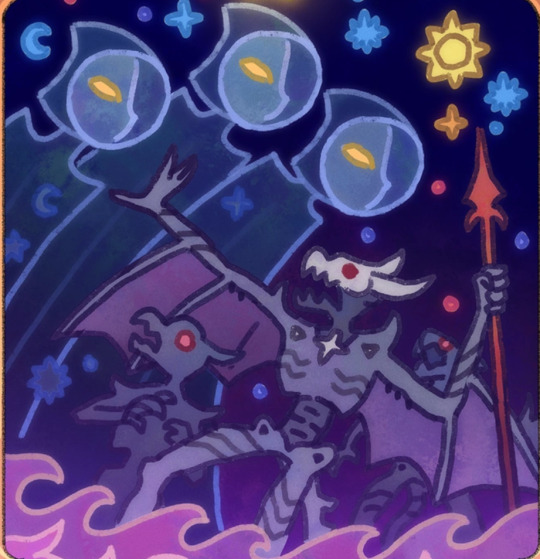
Thirdly; Both Have Messed With the Native Intelligent Life
When the Archivists discovered that the dominant intelligence in the Demon Realm had magical powers that could cancel out theirs, they engaged in a covert genocide against them (the titans). They presented themselves as gods to the lower lifeforms, the original Titan Trappers, and presumably gave them weaponry and knowledge to wipe out the titans.
As seen in "O Titan, Where Art Thou" a connection could be made through allowing the Collector to access dreams, as seen with King in later episodes. (SPOILER WARNING) Furthermore, in "Watching and Dreaming" the Collector uses dream manipulation to torment King, Luz, and Eda with their worst fears.
Now, what does the Observer also do? Manipulates dreams, specifically with the intent to commit a genocide "for the greater good of the project".
For some background, the dominant species on Serina at the time are penguin like canary descendants known as Gravediggers. There are other intelligent lifeforms too, but they are not nearly as adaptable as the former. The Observer begins to realize the horrifying potential the species is capable of when they discover massive coal deposits, which they use to directly warm the planet. Granted, this is to keep the narrow waterway of their nearly frozen over planet from closing, but a Pandora's Box was now open.
The only way he sees the Gravediggers not plunging the planet into a hellish nuclear war is to directly intervene. Using his almost omnipotent knowledge, he finds the perfect candidate in the form of a crow like bird named Brighteye. He is special, being the only member of his species to be sapient and understand more abstract concepts, the only one with the ability to dream.
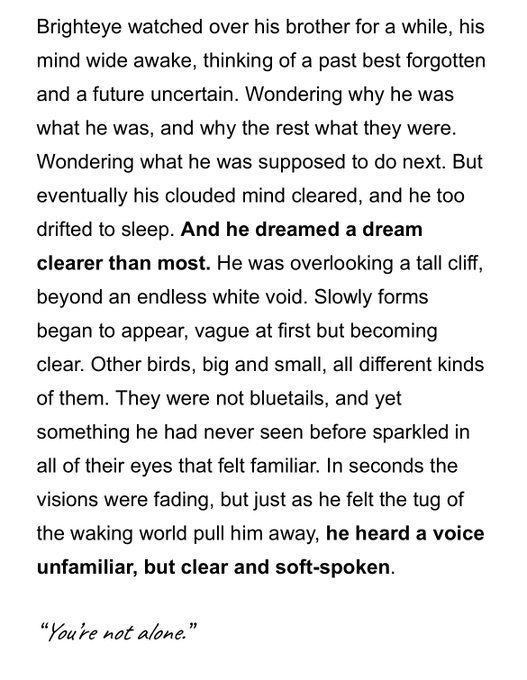
After experiencing his brother, Whitecrown, nearly get brutally slaughtered at the hands of his own family due to his albinism, the Observer swoops in to give him hope of a future for him and his brother. He pushes Brighteye to find others like him, and there they will be safe. But unbeknownst to him, doing these actions would make him a harbinger of the apocalypse.
The story is much more layered than what I'm describing, but by the end of it the apocalypse does come to fruition, and by Whitecrown of all characters. Him fighting and leaving his sibling was guaranteed by his instinctual behavior, something that the Observer always knew was going to happen. Although he isn't sapient, he is still intelligent, and replicates the fire making abilities of his brother to hunt animals.
Remember those "massive coal deposits" I mentioned earlier? Whilst flying above the grasslands, Whitecrown accidentally drops the burning stick onto one of them, causing a massive explosion that kills him and the rest of his flock.
As the smoke gets to Brighteye, he hears the Observer one last time...

The fire continues to expand outward, soon consuming the entire continent in flames. The warmth from the fire will melt all of the ice, plunging the land of the Gravediggers under several hundred feet of water. For a time, it also turns the atmosphere into something akin to an oven, cooking / suffocating anything that's too close.
Does this sound familiar?
In the second half of the storybook King reads, underneath scribbled crayon markings, it states;
"But should they meddle in our affairs..."

"...We'll clean the planet and scorch the air."
...
Now, there are a lot more things that I haven't covered, but I think these are the three most important ones. In no way am I saying one of them copied the other, considering that The Observer was first mentioned all the way back in 2015, and the fact that neither of these fandoms are connected in any way.
Still, I find it cool how remarkably similar they are to each other in those ways. If anyone is interested, here's the link to the Serina website, where the story of these strange birds continues:
#the owl house#toh#the collector#watching and dreaming#for the future#king clawthorne#serina#serina the world of birds
40 notes
·
View notes
Text
let's talk about trump and the tea party.
for folks who are a bit younger, you may or may not remember that the response to obama's 2008 election from the right was to fracture: the tea party was a grassroots movement of right-wing folk who thought the GOP was too centrist and corrupt. they positioned themselves as defenders of the constitution and, essentially, a populist party composed of the scions of the founding fathers, hence the name 'the tea party' and the adoption of 18th century iconography like the 'don't tread on me' flag and tricorne hats. they won a bunch of seats in congress and having to capitulate to them in the name of diplomacy created a lot of the deadlock that obama ran up against when his administration tried to do anything following the 2010 mid-term elections. this became the blueprint for what constitutes 'normal' behavior in american politics.
trump became a media darling both because he was regularly on tv on 'the apprentice' (all the way until 2015 when he was fired by nbc over his remarks on mexican immigrants while campaigning) and because his tweets became really popular among tea party members. he was the one who really put fire in the rumor that obama was born in kenya by tweeting about it, he rallied people with cries of 'show us your birth certificate,' and his jabs at obama were taken very seriously by what would become his core base. this was how he launched his political career.
i do not think we would have q-anon without the tea party. project 2025 has been in the works thru a network established in the reagan era (side note: please sign up for sarah kendzior's substack. she was a political journalist specializing in covering autocracies before trump was elected and i've been following her since then), but their methods have become much less subtle the more the right is rewarded for their unhinged tactics and outright insurrection.
if trump goes away, the momentum behind his base is still a threat to the world. if he is defeated at the polls, his base is going to take that as proof of the vast conspiracy they have constructed around him. and the truth is that individuals within the democratic party are beholden to the network organizing project 2025 even if they don't agree with nor explicitly endorse their aims. the dnc is actively campaigning against their own members who are unfriendly to AIPAC, like jamal bowman, and biden is talking about how only god could make him step down at this point.
i don't blame people for being afraid, but i will blame folks who are choosing to point their fear at a strawman version of the left instead of recognizing that we have been hamstrung by our own. what should be a time to reinvest in our mutual values has become a frenzy of panic and regression. we can't go back to 2019. wear a mask and see if there a street medic training or a mask bloc or food distro near you.
#like - why do most folks still call the affordable care act 'obamacare?' the tea party said it as a racist jab#the idea was that he was taking white people's tax money and spending it on programs that primarily benefitted black people#which LOL#but racism and specifically anti-blackness has been the locus of reactionary politics in america for time immemorial#if we don't respond on that level it's not a meaningful resistence
4 notes
·
View notes
Text
Treat Your S(h)elf: Gates of Fire by Steven Pressfield (1998)
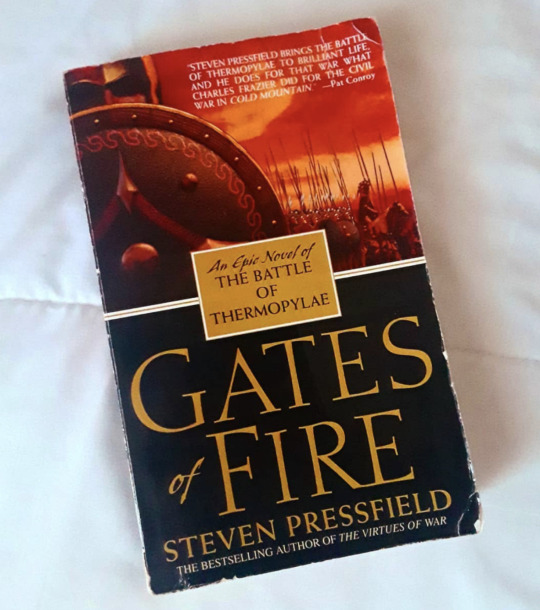
At Thermopylae, a rocky mountain pass in northern Greece, the feared and admired Spartan soldiers stood three hundred strong. Theirs was a suicide mission, to hold the pass against the invading millions of the mighty Persian army.
Day after bloody day they withstood the terrible onslaught, buying time for the Greeks to rally their forces. Born into a cult of spiritual courage, physical endurance, and unmatched battle skill, the Spartans would be remembered for the greatest military stand in history–one that would not end until the rocks were awash with blood, leaving only one gravely injured Spartan squire to tell the tale….
- Steven Pressfield, Gates of Fire (1998)
This is one of my favourite books on war I’ve ever read. I took my dog-eared copy with me last year when I went with ex-military veterans friends to climb Olympus and hike around Greece. One of the places we stopped was Thermopylae - where you can still bathe in the hot springs as the ancient Spartans and Athenians did before their monumental battle with the Persians. The very recent death of the last king of Greece, King Constantine II of the Hellenes, made me think of my trip to Greece last year and of one of the books I read on that trip. I thought I might share some of my rambling thoughts I had written down at the time, and also since then, about the retelling of one historical turning point in our western civilisation that has now entered into myth.
In 1998 was the year Frank Miller’s iconic comic graphic novel 300 about the the Battle of Thermopylae – where a tiny Greek force led by 300 Spartans held out for three days against an immense Persian invasion in 480BC - was published to great critical acclaim. Zack Snyder highly stylised slick film version of Miller’s 300 defied audience and studio expectations when it stormed the box office with Spartan-like ferocity back in 2007. Its mix of ancient history, comic-book iconography and sound-bite dialogue immediately found its way into the verbal and visual lexicon of contemporary pop culture; but things could have been very different. In 1998 Miller’s publication overshadowed the publication of Steven Pressfield’s more conventional historical novel, Gates of Fire, took its name from the eponymous battlefield, Thermopylae (referred to in 300 as ‘the hot gates’).
Pressfield, an ex-Marine soldier, had worked as a screenwriter creating disposable action-movie scripts for the likes of Steven Seagal and Dolph Lundgren in the late 1980s and early 1990s before writing his first novel, The Legend of Bagger Vance, which was adapted into the Will Smith film of the same name. It too won critical acclaim and was a huge best seller. George Clooney’s film production company bought the rights and David Self (screenwriter of 13 Days and Road to Perdition) was brought in to adapt it. Bruce Willis was dying to be in it and iconic director Michael Mann signed on the direct it. Instead the film went into development hell before Snyder’s film stole a march on Mann’s version to come out first in 2007.
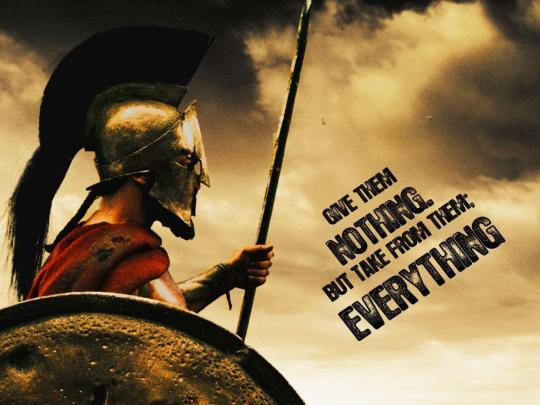
As a Classicist and ex-veteran I found Both Miller’s comic graphic novel and Snyder’s film a severe guilty pleasure. But I have to say I found reading Steven Pressfield’s brilliant novel deeply satisfying on many more levels.
The book I remember well as an American special forces chap I knew out in Afghanistan gave it to me to read because I was complaining I was fast running out of things to read between missions. I loved it.
Like a good officer I passed the book along to others in my corps - rank and file - and within a month or two it had been passed around a fair bit. It led to endless arguments about the Greeks and the Western way of war in and out of the cockpit with my brother/sister aviators and crew as well other officers and the men.
For the soldiers on the ground the book felt more visceral. As a fellow brother British infantry officer said the depictions of phalanx warfare raised his blood pressure at how well he and his men could relate. I never felt more Spartan than I did I sitting on my arse baking in the sun of Afghan red dust mornings. We all related to this story one way or another - the sand, sweat, blood, feelings of combat, and thoughts of mortality.
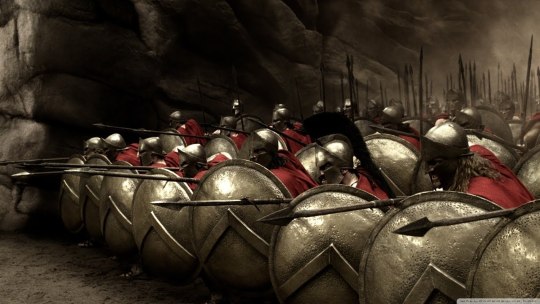
Most book reviewers loved the book. “Does for (Thermopylae) what Charles Frazier did for the Civil War in Cold Mountain’, enthused author Pat Conroy. The New York Times praised the book’s ‘feel of authenticity from beginning to end.’ Author Nelson DeMille admired the ‘mastery, authority and psychological insight.’ Sarah Broadhurst, in The Bookseller, particularly wanted to recommend the book to women: “ Although it has a male feel to it, it will appeal to both sexes, as my two readers and I can testify. In fact, it is a great example of the rebirth of the historical novel, which I am sure is on its way.” Where people quibbled, it was usually about the violence of some of the descriptions, or on small errors of fact. The Times called it ‘a story of blood, biffing and bonking, thigh deep in blood, terror-piss and entrails’ but acknowledged that ‘their heroism still makes the hairs at the back of the neck bristle’. The Times Literary Supplement sniped at Pressfield for confusing two different Greek cities called Argos, and for what it called ‘phallocentric discourse’, but also called the book ‘a monument to the important twentieth-century art of pace.’
The novel stands out in the way it makes everything come alive from the soldiers' training, the scenes of actual battle, and most particularly the scenes after or between battles. The discussions of fear, and of how officers and soldiers should behave are particularly poignant and also felt very real to those of us who have experienced war first hand. What I found pleasantly surprising was how well written it was with its very strong portrayals of women as secondary characters. With nearly all military books women are often relegated to the background but here I found some of the strongest depictions of women in this genre. The women don't fight in the battles, yet are courageous and compassionate, intelligent and influential.
Many readers will be familiar with the broad strokes of the story of the battle. But it’s worth recapping here for those that don’t. In 480 BC, King Xerxes lead a Persian army of between one and two million into Greece. The Spartan King Leonidas lead 300 Knights and some 700 Thespaian allies to the narrow pass at Thermopylae, in order to hold the Persians back as long as possible. They proceeded to hold the pass for 7 days. These 300 Spartans died to a man defending the pass against a force of over a million and the epitaph provided to them by the poet Simonides, "Go tell the Spartans, stranger passing by, that here obedient to their laws we lie", is perhaps the most famous in history. Their example rallied and inspired all of Greece and eventually the Persians were defeated in the naval battle at Salamis and on land at Plataea.
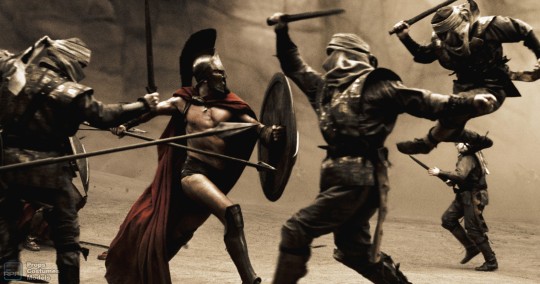
The story is told from the point of view of its narrator Xeones of Astakos, a helot, a slave of the Spartans, and has his own conflicted feelings about Spartan society. He is taken, wounded, before Xerxes, and asked to explain “who were these foemen, who had taken with them to the house of the dead ten or, as some reports said, as many as twenty for every one of their own fallen?” In Xeones’ own words, therefore, we get the story of his life; from when his own city is destroyed, to when he comes to Sparta as a slave, to the time when he finally comes to stand beside the Spartiate in the fateful battle. As the sole survivor among the Spartans, Xerxes wishes Xeones to tell his story to the Persian court historian Gobartes. Xeones starts with the tale of how he came to Sparta. As a youth, his village of Astakos is destroyed and his family slaughtered, but he and the cousin he loves, Diomache, escape. As they wander the countryside, Diomache is raped by soldiers and Xeones is crucified after stealing a chicken, although Diomache saves him from death. Thrown into despair, because his hands are so damaged that he can never wield a sword, Xeones heads off by himself to die. But he experiences a visitation from the Archer god Apollo Far Striker and realizes he can still wield a bow. When Diomache, who is also distraught after being violated by the soldiers, takes off, Xeones heads to Sparta where he hopes to join the army.
The middle section of the book, which is at a much slower pace, deals with his life in Sparta and the training techniques used by the Spartans to create what was one of the most formidable fighting forces the world has ever seen. Eventually he becomes the squire of one of the 300 knights who are chosen for Thermopylae.
The final section, on the battle itself, depicts wholesale slaughter accompanied by acts of ineffable courage. It also relates two of the great lines of all time. When Xerxes offers to spare the Spartans lives if they will surrender their arms, Leonidas is reputed to have snarled, "come and get them." And upon being told that the Persians have so many bowmen that the cloud of arrows would blot out the sun, one of the Spartans says, "good, then we'll have our battle in the shade."
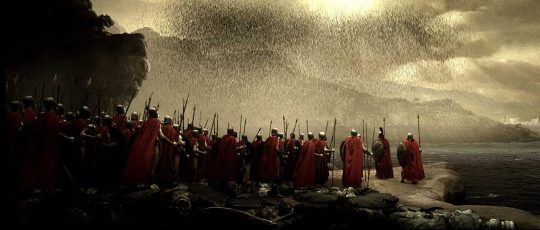
Pressfield being an ex-Marine grunt himself gives a very convincing grunt’s-eye-view of the battle and of Spartan society to create a fantastically blood pumping engaging tale. Pressfield sets himself the task of explaining Spartan culture to us in all its glory, humour, brutality and philosophy. To do so, he draws on his personal experience as a US infantryman, as well being strongly versed in Classics. The result is a fascinating tale, on one level a war story written with great pace and excitement, on another a ruminative tale of man’s capacity for honour, heroism, and self-sacrifice.
As a Classicist (since confirmed by Pressfield in many interviews) he makes excellent use of the ancient historical sources (such as they are). The most useful sources seem to be Herodotus first, his pages about the battle. Plutarch’s Lives of various Spartans — Lycurgus, Agesilaus, Lysander, etc - can be discerned strongly as the section of his Moralia called Sayings of the Spartans and Sayings of the Spartan Women. Xenophon of course was the best contemporaneous eyewitness to real Spartan society. Constitution of the Lacedaemonians, the Cyropaedia and even the Anabasis greatly help Pressfield pepper history with authentic detail. Diodorus’ version of the battle added the thought of the night raid (which The 300 Spartans also had) and Pressfield takes that from him. Pressfield has said that he didn’t consult recent archaeology, other than going to Sparta myself and checking out the ruins of Artemis, Orthia and so forth.

But still huge gaps remained. This is where Pressfield the ex-Marine and the well educated novelist come together. There was much detail that he needed to consciously to make up and make it sound plausible and even true. For instance, the concept of phobologia, the Science of Fear. That’s completely invented, yet Pressfield, as a Marine veteran, absolutely felt certain the Spartans, like every other warrior race, must have had something like that, a religious-philosophical doctrine of warfare understanding the principles of their culture, probably a sort of cult-like initiatory situation.
Pressfield in one interview admitted that the speech that Alexandros recites holding his shield — “This is my shield, I bear it before me into battle, etc.” — was a fictional invention based upon his own experience in the US Marine Corps, where Marines recite, “This is my rifle. There are many other like it, but this one is mine, etc.” Another huge fictional detail that he made central to the story was the prominence of the squire in hoplite battle. Again he based this on pure instinct and common sense. He thought the relationship must be much like that of a professional golfer to his caddie. Pressfield firms believes that the bonds formed between man and batman in the course of bloody warfare must have been intimate on a level second only to husband and wife, and maybe more intimate. The ancient sources make nothing of this, because they just passed it over as obvious, but I fully agree with Pressman. It’s an inspired insight. The fact that squires and armour bearers voluntarily stayed to die at Thermopylae says volumes. (Also a squire was the perfect fly-on-the-wall narrator, like Midshipman Byam in Mutiny on the Bounty.) Further I could not imagine that squires would stand idly by, watching their men fight. They must have served as auxiliaries, not only dashing in and out of the field evacuating the wounded, but getting in their blows as light infantrymen whenever they could. I suspect that, as prominent as Pressfield made their roles in Gates, if we could beam ourselves back and witness actual ancient battle, the part of the squire/auxiliary was even bigger than one might imagine.

The book then is not merely about the immortal stand at Thermopylae but delves into the Spartan lifestyle, how they achieved such military cohesion, how they viewed themselves and the world, what made them willing to march off to a suicide mission — it’s one thing to find oneself in such a situation, it’s quite another to jockey to be chosen for it, to know days ahead of time that this is it, you’re heading to your death and to do it unflinchingly. It’s about what binds men together in a group — what makes them willing to die for others. I think Dienekes’ thoughtful analysis of fear and how the opposite of fear isn’t bravery but love, tells it all. Love of a messmate, a family, a city.
Indeed as Pressfield shows the spartans would carry their shields on the left side of their body which allowed them to cover the blind spot of the warrior fighting next to them. Commanders would arrange it so that family members and friends were placed next to each other within the formation. The belief was that warriors would be less likely to abandon their comrades if they were fighting next to someone they deeply cared about. Love conquers fear.
Now the story isn’t perfect, there are some pacing issues when the plot seems to go extra slow, and there are time jumps that can feel a bit awkward. Some periods of our main protagonist’s life, that would be interesting, are just skipped.
In my opinion, the book balances fiction and facts quite nicely, not making the Spartans some over the top super heroes, like the movie “300” did.
The thing that I liked the most is the whole theme of the book: honour, the duty to your city and people, and the strength of the mind. The Spartans didn’t see war as a fun way of killing people, it was an inevitable fact of life. They didn’t kill fear, they learned to embrace it, keep it locked until the very last moment.
Now it’s a bit harder to judge characters in a book like this because some of them are based on real people and some of them are fictional. But what I will say is that these people feel real, grounded to the situation they are in.

I was very taken by the portrayal of Leonidas, the Spartan king who commanded at Thermopylae. One of the most stirring speeches in the book is addressed to Xerxes, the King of Persia, and contrasts Xerxes with Leonidas: "I will tell His Majesty what a king is. A king does not abide within his tent while his men bleed and die upon the field. A king does not dine while his men go hungry, nor sleep when they stand at watch upon the wall. A king does not command his men's loyalty through fear nor purchase it with gold; he earns their love by the sweat of his back and the pains he endures for their sake….”
I also appreciated the inclusion of the women of Sparta — no shirkers themselves. They would be the first ones out shaming the men into doing their duty for their city (and that’s what it was all about for these people — the survival of the city first) if that was what was needed. I have to say I shed a tear when Leonidas confessed his criteria for selection of the 300. So much is said about Spartan men but the women kicked ass in a time and place where women were almost never seen and certainly never heard from. The first female Olympic champion was a Spartan princess called Kynisca, in 392 BC. She was also the first woman to become a champion horse trainer when her horses and chariot competed and won in the Ancient Olympic Games. Twice.
Arete is in some ways the most powerful character in the book. She is very well written. She just popped forth, full-grown from the brow of Zeus. I liked her a lot. Whether or not Sparta was a “good” place for women I can’t say. Certainly it would be fascinating as hell to beam back there and see, for real, how they lived and what they were like. It seems likely Pressfield drew inspiration of Arete from Plutarch’s Sayings of the Spartan Women. These, if you’ve ever read them, are unbelievably hard-core. For example, here’s one: A messenger returns from a battle to inform a Spartan mother (Plutarch gives her name but I’ve forgotten it) that all five of her sons have just perished honourably fighting the enemy. She asks this only: “Were we victorious?” The courier replies yes. “Then I am happy,” says the mother and turns for home. Here’s another: A messenger returns from another battle to tell another mother that one of her sons has been killed, facing the enemy. “He is my son,” she says. Her other son, the messenger continues, is still alive but ran from the enemy. “He is not my son,” she replies. Pressfield doesn’t see Arete quite that hard-core but certainly someone tough as nails who imbibed the Spartan mythos even more than the men and lived it. Pressfield admits in one of his interviews that this was all instinct, he could be wrong, but itt just was what felt right to him.

Before I had gone through Sandhurst after university I didn’t really condone crude language or lewd humour but it’s one of the ways that my stint in the army and especially out on a battlefield deployment changed me a little. I confess that I loved the sometimes crude humour - they’re soldiers in a time of war and you do or say whatever will get you through. Battle (especially foxhole) humour has a dark gallows feel and it’s entirely acceptable and authentic - just ask any veteran of any war. The battle descriptions are graphic - very graphic but not much worse than what’s in the Iliad. And we are talking about a battle in which thousands died by sword, spear, arrow and other various messy methods.
I also enjoyed how the book has a pleasing prose aesthetic that imitates the style of Homer. For the non-Classicist it may take a little bit of getting used to and slow down their reading but it sounds melodious to the ear.
Overall Pressman gives us a pulsating story in which the characters are not either super evil villains that cartoonishly want to “take over the world” or superheroes that can’t make mistakes. The author doesn’t take a side in this story, war is war, and people are people. They make mistakes, get angry or jealous, they do bad things in the name of good and vice versa. The book is not about good and evil, it’s about how different people and cultures understand the order, stability, good and even our minds and dreams. The enemies here aren’t some sort of Oriental magic freaks from far away lands, they are just men made in flesh and blood. Sure wanting to control more land or have more people serving them, but that’s everyone I know in the history of rise and fall of civilisations.
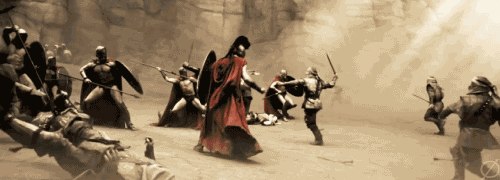
Was the Spartan defence of the Hot Gates worth it?
Clearly, yes. Cultures, if not civilisations, are nearly always rubbing up against each other and even clashing where they can’t bridge differences. I think Pressfield has it right when he said, “What the defence meant to me was this: its significance was metaphorical rather than literal. We are all in a battle that will end with our deaths and, like the Spartans at Thermopylae, we know it. The question is how do we deal with it. They answered by being true to their calling, to their brothers and sisters, and to their ideals. Early in the book there’s a passage where the Persian historian is narrating; he’s speaking of King Xerxes and his interest in the fallen Spartans. Xerxes says of them: “He knew they feared death, as all men. By what philosophy did their minds embrace it?”
In two of my favourite passages, Pressfield has his protagonist explain why sacrifice is so beautiful to the Greeks (or to anyone who has honour), "In one way only have the gods permitted mortals to surpass them. Man may give that which the gods cannot, all he possesses, his life”. This is a very profoundly moving insight.
Pressfield goes further and tries to answer a much deeper question as to why men fight and perhaps this is where it’s the ex-Marine and not the novelist in Pressfield who is talking, "Forget country. Forget king. Forget wife and children and freedom. Forget every concept, however noble, that you imagine you fight for here today. Act for this alone: for the man who stands at your shoulder."
Amen to that.
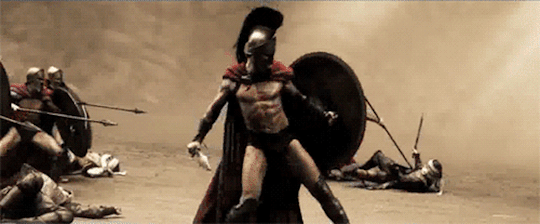
At the end of the book, I would have probably stranded there fighting side by side with them against the Persians. Because at that point, they were my friends, comrades, and heroes. It was when I put the book down that I realised that I already had the humble privilege of serving with my fellow brother and sister officers and soldiers of whom all were comrades, many were friends, and a few were unspoken heroes.
Does the battle of Thermopylae provide any lessons to us?
That is harder to discern because it depends on what values we already hold dear. Sparta was a small, compact, basically tribal society where every citizen (forgetting about the helots for the time being) was vitally needed and where warfare was hand-to-hand and absolutely communal, with your own brothers, uncles, father and friends fighting beside you, so if you acted the coward, there was no hiding it. The modern world of anonymity, mass culture, commercialism, shamelessness, indulgence of sensual desires, worship of money couldn’t be farther. The Spartan society is like a culture from the moon.
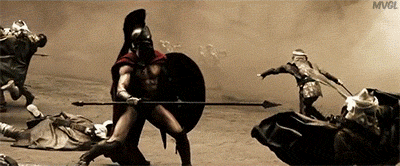
On an individual and interior basis, I think, can we take lessons that might help us. Self-discipline, loyalty, grit, hard work, perseverance, honour, humility, respect, and compassion.
On a societal level Spartans were not selfish and didn’t worship the cult of individualism as we do today. It was all about the group. In our age when civil strife, economic hardship, and effects of a unrelenting pandemic erode our trust in our political and civil institutions and set neighbour against neighbour because of the political or religious beliefs they might hold, the only thing we have left to fall back on is just our individual selves. It’s every man for himself. The Spartans would balk at such selfish individualism. The strength (and ultimately the effectiveness) of the Spartan phalanx was encapsulated in the “next man up” approach. If a warrior was injured or killed on the outer edge of the formation, the next man behind them would step up and take their place. The integrity of the group’s formation was protected at all costs, because without the strength of the phalanx to protect them, each man on had little chance of surviving the battle on his own. In a real sense, they had each other’s backs. They had the cohesion of a collective spirit. They were in it for each other together.
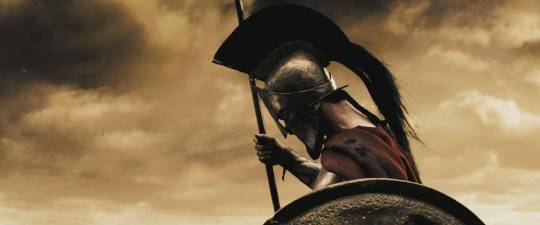
It’s not a bad thing in this day and age to be a little bit “spartan,” don’t you think?
#treat your s(h)elf#book#review#book review#reading#gates of fire#steven pressfield#sparta#thermopylae#persia#leonidas#xerxes#society#culture#antiquity#classical#greece#war#warfare#special forces#british army#US marines#battle#soldiers#arete#women#afghanistan#civilisation#TYS
45 notes
·
View notes